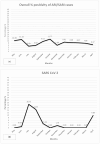Hospital-Based Surveillance of Respiratory Viruses Among Children Under Five Years of Age with ARI and SARI in Eastern UP, India
- PMID: 39861815
- PMCID: PMC11769465
- DOI: 10.3390/v17010027
Hospital-Based Surveillance of Respiratory Viruses Among Children Under Five Years of Age with ARI and SARI in Eastern UP, India
Abstract
Acute respiratory infections (ARIs) are a leading cause of death in children under five globally. The seasonal trends and profiles of respiratory viruses vary by region and season. Due to limited information and the population's vulnerability, we conducted the hospital-based surveillance of respiratory viruses in Eastern Uttar Pradesh. Throat and nasal swabs were collected from outpatients and inpatients in the Department of Paediatrics, Baba Raghav Das (BRD) Medical College, Gorakhpur, between May 2022 and April 2023. A total of 943 samples from children aged 1 to 60 months were tested using multiplex real-time PCR for respiratory viruses in cases of ARI and SARI. Out of 943 samples tested, the highest positivity was found for parainfluenza virus [105 (11.13%) PIV-1 (79), PIV-2 (18), PIV-4 (18)], followed by adenovirus [82 (8.7%), RSV-B, [68 (7.21%)], influenza-A [46(4.9%): H1N1 = 29, H3N2 = 14), SARS CoV-2 [28 (3%)], hMPV [13(1.4%), RSV-A [4 (0.42%), and influenza-B (Victoria lineage) 1 (0.10%). The maximum positivity of respiratory viruses was seen in children between 1 to 12 months. The wide variation in prevalence of these respiratory viruses was seen in different seasons. This study enhances understanding of the seasonal and clinical trends of respiratory virus circulation and co-infections in Eastern Uttar Pradesh. The findings highlight the importance of targeted interventions to reduce the burden of respiratory infections in this region.
Keywords: ARI; human metapneumovirus (hMPV); parainfluenza virus (PIV); respiratory syncytial virus (RSV); severe acute respiratory infection; under 5 children.
Conflict of interest statement
The authors declare no conflicts of interest.
Figures






References
-
- Mulambya N.L., Nanzaluka F.H., Sinyangwe N.N., Makasa M. Trends and factors associated with acute respiratory infection among under five children in Zambia: Evidence from Zambia’s demographic and health surveys (1996–2014) Pan Afr. Med. J. 2020;36:197. doi: 10.11604/pamj.2020.36.197.18799. - DOI - PMC - PubMed
Publication types
MeSH terms
Grants and funding
LinkOut - more resources
Full Text Sources
Miscellaneous

